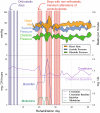Transient alteration of consciousness in spinal cord injury secondary to Baclofen use: a case report
- PMID: 35597797
- PMCID: PMC9124195
- DOI: 10.1038/s41394-022-00511-z
Transient alteration of consciousness in spinal cord injury secondary to Baclofen use: a case report
Erratum in
-
Correction: Transient alteration of consciousness in spinal cord injury secondary to Baclofen use: a case report.Spinal Cord Ser Cases. 2023 Aug 18;9(1):44. doi: 10.1038/s41394-023-00601-6. Spinal Cord Ser Cases. 2023. PMID: 37596275 Free PMC article. No abstract available.
Abstract
Introduction: Oral baclofen is commonly used for spasticity management, especially with neurogenic bladder in spinal cord injury (SCI). A less common side effect of baclofen is transient alterations of consciousness, which can easily be confused for altered mental status secondary to orthostatic hypotension in SCI.
Case presentation: A 43-year-old man with an acute SCI secondary to an aortic dissection was found to have episodes of confusion after titrating oral baclofen from 5 mg three times per day to 10 mg three times per day at an acute rehabilitation facility. Orthostatic hypotension was initially suspected as the cause of transient alterations of consciousness; however, he was never found to be hypotensive during these episodes. His confusion resolved several days after discontinuation of baclofen.
Discussion: Although, confusion and lightheadedness in SCI are commonly caused by orthostatic hypotension, it is important for physicians to be cognizant of baclofen's side effects, which increase in the setting of acute kidney injury (AKI). If an adverse effect is suspected, baclofen should be tapered while remaining observant for signs of baclofen withdrawal, which can be life-threatening. This case report is a reminder for clinicians to be aware of the uncommon adverse effects of baclofen when initiating therapy in SCI, especially in patients with AKI and neurogenic bladders.
© 2022. This is a U.S. government work and not under copyright protection in the U.S.; foreign copyright protection may apply.
Conflict of interest statement
The authors declare no competing interests.
Figures

Similar articles
-
Bladder stones - red herring for resurgence of spasticity in a spinal cord injury patient with implantation of Medtronic Synchromed pump for intrathecal delivery of baclofen - a case report.BMC Urol. 2003 Mar 25;3:3. doi: 10.1186/1471-2490-3-3. Epub 2003 Mar 25. BMC Urol. 2003. PMID: 12659647 Free PMC article.
-
Baclofen Unusual Response In Spinal Cord Injury Patients.J Ayub Med Coll Abbottabad. 2019 Apr-Jun;31(2):269-271. J Ayub Med Coll Abbottabad. 2019. PMID: 31094129
-
Midodrine: insidious development of urologic adverse effects in patients with spinal cord injury: a report of 2 cases.Adv Ther. 2007 Jul-Aug;24(4):712-20. doi: 10.1007/BF02849965. Adv Ther. 2007. PMID: 17901021
-
Role of Baclofen in Modulating Spasticity and Neuroprotection in Spinal Cord Injury.J Neurotrauma. 2022 Feb;39(3-4):249-258. doi: 10.1089/neu.2020.7591. Epub 2021 Mar 11. J Neurotrauma. 2022. PMID: 33599153 Review.
-
Encephalopathy of Unknown Origin in a Baclofen Patient: Case Report and Review of the Literature.World Neurosurg. 2020 Apr;136:136-139. doi: 10.1016/j.wneu.2020.01.044. Epub 2020 Jan 16. World Neurosurg. 2020. PMID: 31954899 Review.
Cited by
-
Case Report: Synergistic central nervous system depression of baclofen and pregabalin: clinical pharmacist-driven case analysis and case review.Front Pharmacol. 2025 Jun 5;16:1598971. doi: 10.3389/fphar.2025.1598971. eCollection 2025. Front Pharmacol. 2025. PMID: 40538539 Free PMC article.
References
-
- Ghanavatian S, Derian A Baclofen. In: StatPearls. Treasure Island (FL): StatPearls Publishing; 2020.
Publication types
MeSH terms
Substances
Grants and funding
LinkOut - more resources
Full Text Sources
Medical

